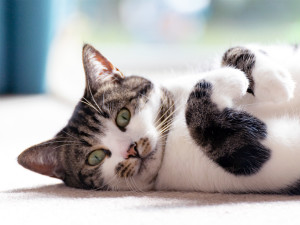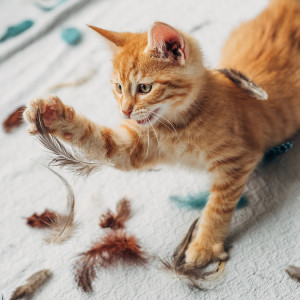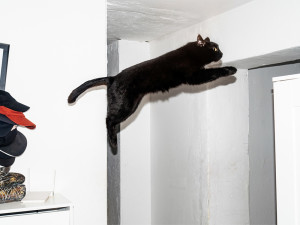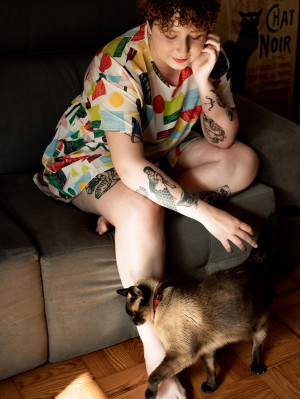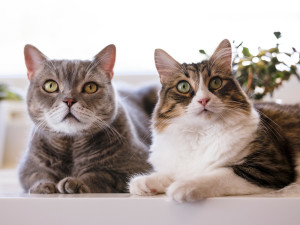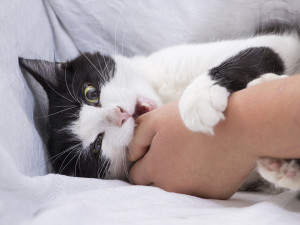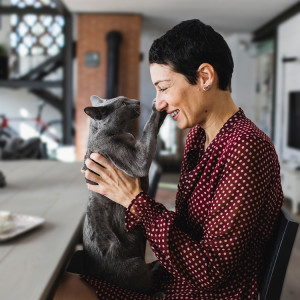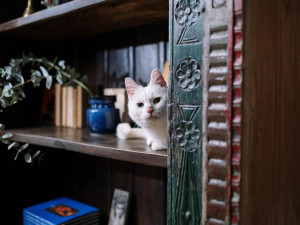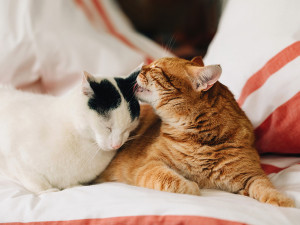Are Cats Liquid?
Taking “if I fits, I sits” to a whole new level...
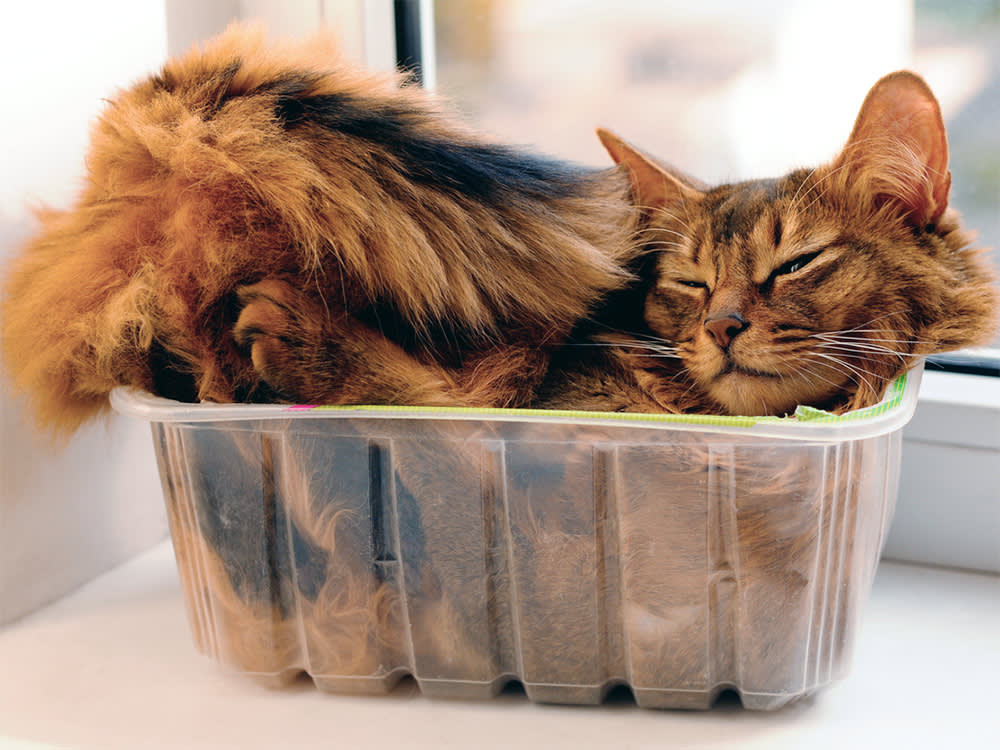
Share Article
It’s no secret that cats seem to defy the laws of physics. One minute, they’re lounging in a box half their size, and the next, they’re squeezing through gaps no human would attempt. But are cats actually as ‘liquid’ as they seem? Recent research helps us better understand just how our four-legged friends manage to twist and turn into seemingly impossible spaces.
The science behind cat flexibility
Cats are incredibly agile due to their unique skeletal structure. Their flexible spines allow for a range of motion far beyond what we humans can manage. They also lack rigid collarbones, which means their shoulders can move in ways that make squeezing through tight spaces a breeze.
“Cats have more vertebrae than people do and between the bones is a gelatinous disk that helps them bend and flex in ways people and dogs cannot,” says Dr Gabrielle Fadl of Bond Vetopens in new tab. “Their spines are like little springs that can be compressed and extended, which is also part of what allows them to jump so far. Cats also have a clavicle that sort of floats, which allows their shoulders to contort and compress to help them get into these tight spaces.”
However, recent research published in iScienceopens in new tab shows that this isn’t just mindless contortionism. The study, led by Péter Pongrácz, tested cats on their ability to navigate through increasingly smaller openings. While cats showed no hesitation when approaching tall and narrow gaps, they did slow down and exhibit more caution when faced with shorter, horizontal openings. This suggests that cats rely on their body-size awareness, especially in more challenging scenarios. As the study puts it, “cats selectively rely on body size awareness when negotiating short openings”.
Why cats squeeze into tight spaces
The instinct to hide or find shelter might explain why cats are drawn to small spaces, but their anatomical prowess takes this to a whole new level. Their highly flexible shoulders and absence of the aforementioned rigid collarbone allow them to “melt” into any space they can fit their heads through.
“In the wild cats are both predators and prey,” says Dr Fadl. “That’s why they hide when they don’t feel well. Because they don’t want to be eaten. At the same time, they squeeze into small spaces in order to hide from their own prey. If they are crouched in a corner, then nothing can sneak up behind them, so this ability serves sort of a dual purpose.”
The extraordinary flexibility also helps cats evade predators in closer quarters. As anyone who has ever tried to grab a cat against their will can attest, cats can be very difficult to get a handle on, when they want to be. It’s this same flexibility that allows them to quickly change direction while running and always land on their feet when falling from high places.
This flexibility, combined with their spatial awareness, means that cats rarely misjudge what they can fit into. The new study from Pongrácz adds another layer to this: while cats often use a trial-and-error method for navigating tall, narrow spaces, they hesitate when a gap’s height is uncomfortably small. Cats seem to be more cautious when they have to crouch or crawl, indicating that vertical height is more important to them than width.
This could have something to do with a cat’s use of their whiskers as ‘sensors’ to judge potential paths. “A cat can generally fit into anything their head can fit into,” says Dr Fadl. ”So if their head can fit under or through something (like the neck of a glass vesselopens in new tab), the rest of their body should be able to as well, as long as there is room. They use their whiskers to help measure space and get a full sensory picture of the situation.”
Although it’s rare, it’s not entirely true that cats never get stuck (as much as they'd like us to believe they never make mistakes). Cats, especially curious ones, sometimes misjudge their body’s ability to fit into tiny spaces. According to the study, the hesitation they show before entering particularly small spaces reveals that they have some level of body-size awareness. It’s a calculated risk. If they do get stuck, it’s likely because the space wasn’t quite what they expected or they underestimated the challenge.
What happens if they do get stuck? “Typically, if they can wiggle themselves in then they can wiggle themselves out,” says Dr Fadl. Their wonderful flexibility and tendency to hide in small spaces is “really only a problem if your cat is squeezing into dangerous areas, like hiding between the dryer and the wall,” says feline behaviour specialist Dr Marci Koski of Feline Behavior Solutionsopens in new tab.
“I’ve known cases where the cat got electrocuted in those situations, so if you know your cat likes to go into small places, it’s a good idea to block dangerous areas off,” says Dr Koski. “If your cat has a thing for squeezing into boxes, leave some boxes out for them. That’s a safe alternative.”
So, are cats really liquid?
In a metaphorical sense, cats do behave like liquid – adapting their shape to whatever container or gap they encounter. However, this new research highlights that cats aren’t just flowing without thought. They make deliberate decisions based on the space they’re trying to enter, relying on both their physical abilities and a keen sense of body awareness.
The next time you see your cat squeezing into an impossibly small box, you’ll know they’ve calculated every inch of space, proving that while cats may seem like liquid, they’re also savvy spatial thinkers. “If I fits, I sits,” indeed.

Charles Manning
Charles Manning is an actor, writer, and fashion/media consultant living in New York City with his two cats, Pumpkin and Bear.

Orla Pentelow
Orla Pentelow is Kinship UK’s Senior Editor. She has previously written for British Vogue, Bustle, Yahoo and The Telegraph. When not at her desk liking dog videos she’s out and about with her rescue pup, Luna, who works primarily as chief distractor.
Related articles
![a tattooed person with curly red hair on a couch pets a brown and black cat]()
Can Your Cat Smell If You’re Stressed?
And will they do anything about it if they do?
![Male and female cat lying side by side.]()
Male vs Female Cats: What Are the Differences?
There’s more to it than you might think
![cat biting person's hand]()
Why Did My Cat Bite Me?
Don’t live in fear of your feline overlord. A vet explains why cats bite (and what you can do to avoid their wrath)
![Short haired woman holding a gray cat that's playfully pawing at her nose]()
Does Your Cat’s Fur Pattern Determine Their Personality?
It’s a little more complicated than that
Why Is My Cat Hiding?
No, they’re not on the lam. Here are four reasons your cat might be MIA
![Two tabby cats cuddling each other with their eyes closed]()
Cats Aren’t Loners, After All
Cat behaviourist Kristiina Wilson on the importance of socialising cats

